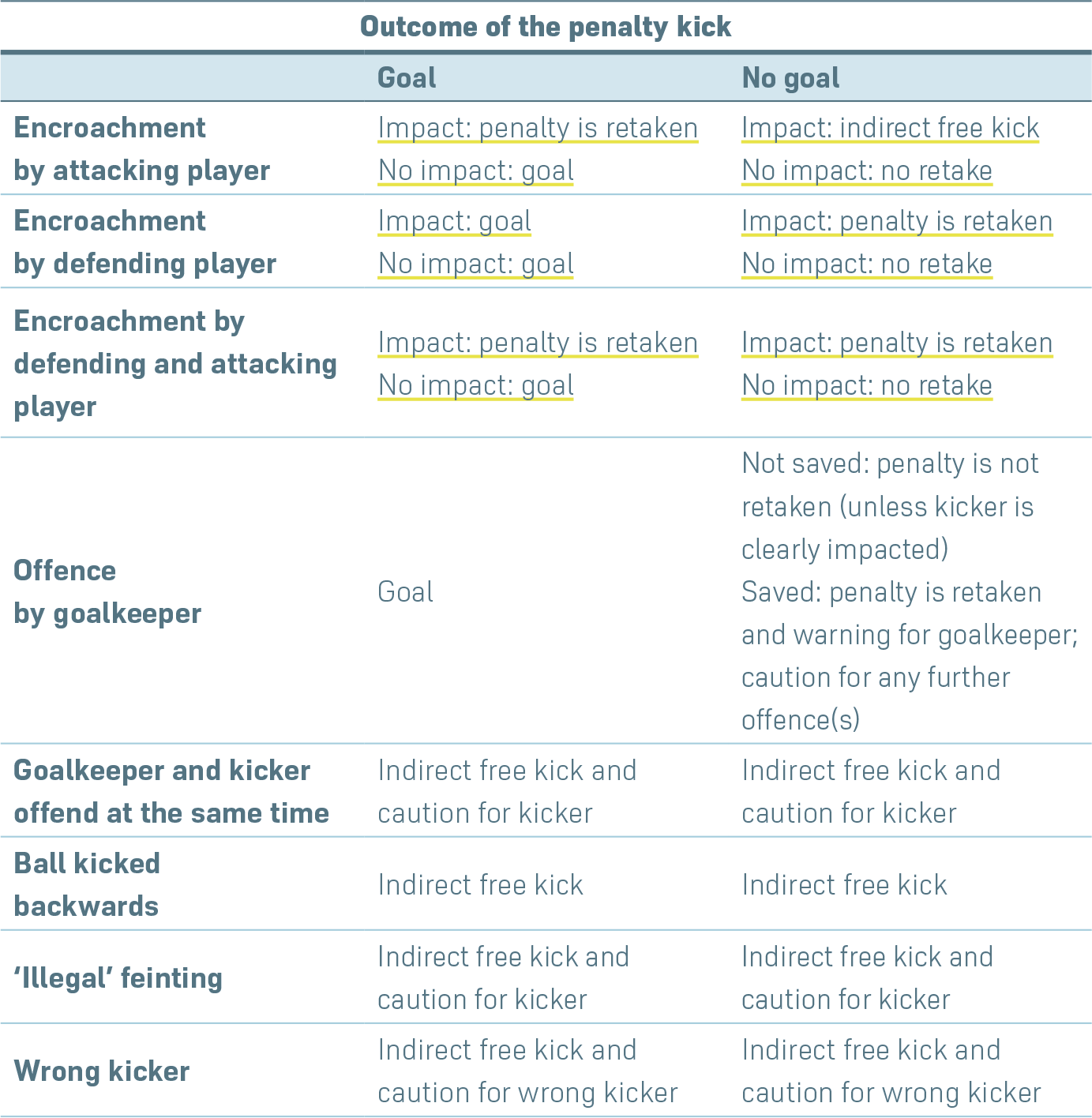A penalty kick is awarded if a player commits a direct free kick offence inside their penalty area or off the field as part of play as outlined in Laws 12 and 13.
A goal may be scored directly from a penalty kick.
0:00/0:17
A penalty kick is awarded if a player commits a direct free kick offence inside their penalty area or off the field as part of play as outlined in Laws 12 and 13.
A goal may be scored directly from a penalty kick.
The ball must be stationary
The player taking the penalty kick must be clearly identified.
The defending goalkeeper must remain on the goal line, facing the kicker, between the goalposts, until the ball is kicked. The goalkeeper must not behave in a way that unfairly distracts the kicker, e.g. delay the taking of the kick or touch the goalposts, crossbar or goal net.
The players other than the kicker and goalkeeper must be:
at least 9.15 m (10 yds) from the penalty mark
behind the penalty mark
inside the field of play
outside the penalty area
After the players have taken positions in accordance with this Law, the referee signals for the penalty kick to be taken.
The player taking the penalty kick must kick the ball forward; backheeling is permitted provided the ball moves forward.
When the ball is kicked, the defending goalkeeper must have at least part of one foot touching, in line with, or behind, the goal line.
The ball is in play when it is kicked and clearly moves.
The kicker must not play the ball again until it has touched another player.
The penalty kick is completed when the ball stops moving, goes out of play or the referee stops play for any offence.
Additional time is allowed for a penalty kick to be taken and completed at the end of each half of the match or extra time. When additional time is allowed, the penalty kick is completed when, after the kick has been taken, the ball stops moving, goes out of play, is played by any player (including the kicker) other than the defending goalkeeper, or the referee stops play for an offence by the kicker or the kicker’s team. If a defending team player (including the goalkeeper) commits an offence and the penalty is missed/saved, the penalty is retaken.
Once the referee has signalled for a penalty kick to be taken, the kick must be taken; if it is not taken, the referee may take disciplinary action before signalling again for the kick to be taken.
If, before the ball is in play, one of the following occurs:
the player taking the penalty kick or a team-mate offends:
if the ball enters the goal, the kick is retaken
if the ball does not enter the goal, the referee stops play and restarts with an indirect free kick
except for the following when play will be stopped and restarted with an indirect free kick, regardless of whether or not a goal is scored:
a penalty kick is kicked backwards
a team-mate of the identified kicker takes the kick; the referee cautions the player who took the kick
feinting to kick the ball once the kicker has completed the run-up (feinting in the run-up is permitted); the referee cautions the kicker
the goalkeeper offends:
if the ball enters the goal, a goal is awarded
if the ball misses the goal or rebounds from the crossbar or goalpost(s), the kick is only retaken if the goalkeeper’s offence clearly impacted on the kicker
if the ball is prevented from entering the goal by the goalkeeper, the kick is retaken
If the goalkeeper’s offence results in the kick being retaken, the goalkeeper is warned for the first offence in the game and cautioned for any subsequent offence(s) in the game
a team-mate of the goalkeeper offends:
if the ball enters the goal, a goal is awarded
if the ball does not enter the goal, the kick is retaken
a player of both teams offends, the kick is retaken unless a player commits a more serious offence (e.g. 'illegal' feinting)
both the goalkeeper and the kicker commit an offence at the same time, the kicker is cautioned and play restarts with an indirect free kick to the defending team
If, after the penalty kick has been taken:
the kicker touches the ball again before it has touched another player:
an indirect free kick (or direct free kick for a handball offence) is awarded
the ball is touched by an outside agent as it moves forward:
the kick is retaken unless the ball is going into the goal and the interference does not prevent the goalkeeper or a defending player playing the ball, in which case the goal is awarded if the ball enters the goal (even if contact was made with the ball) unless the interference was by the attacking team.
the ball rebounds into the field of play from the goalkeeper, the crossbar or the goalposts and is then touched by an outside agent:
the referee stops play
play is restarted with a dropped ball at the position where it touched the outside agent
